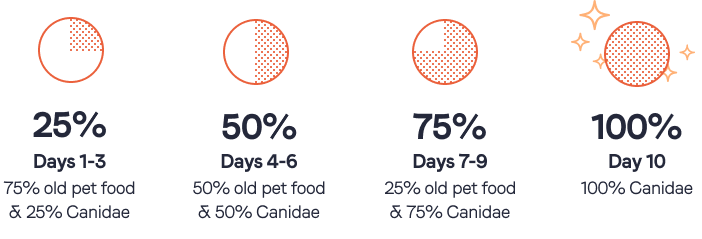Transitioning New Pet Food

How To Transition Dog Food To Canidae

Our high-quality dog food formulas contain more meat and fewer carbohydrates than most other brands. While higher meat to carbohydrate ratios provide a healthier diet for most dogs, making the switch to a more wholesome diet can be tricky. Switching your dog’s food using the “cold turkey” method can lead to upset stomach and other digestive problems. Canidae recommends changing food over a gradual period of time adding the new food to old food in increasing amounts. For most breeds and life stages, a 7-day transition period ensures a smooth and gentle transition to your best friend’s new diet.
Our formulas are also more nutritionally dense than many other brands. In Canidae recipes you can find an animal protein source as the first ingredient, and an ingredient list packed full of wholesome vegetables, vitamins, minerals, fatty acids and amino acids. As a result, your dog may feel fuller and need fewer servings per day than what you may have been feeding previously. Many pets find our food to be more palatable than other brands, so some will want to eat more than their recommended daily amount. Pay close attention and follow the daily servings guidelines on the back of the bag!

How to Transition Dog Food Without Upsetting Your Pet
We have found that the smoothest transition from one dry dog food or wet dog food to another is to simply mix the foods together in order to change your dog’s diet gradually. This food transition process should usually take about seven days until you are feeding your pet 100% of the new food. You can increase the transition time if your dog is particularly sensitive to menu changes.
Any abrupt change to a different diet can cause some pets to experience gastrointestinal upset (for example, loose stools or vomiting). While this upset usually disappears in a matter of days, it can often be avoided by following these simple transition guidelines. Unlike humans, dogs often eat the same dry and wet foods for months or years and their digestive systems are not as used to change as ours are!
When to Switch Your Puppy to Adult Food
Owning a puppy can be exciting, but overwhelming, as first-time dog owners can be overwhelmed with choices — especially when it comes to the decision to switch from puppy food to normal adult formulas. Foods created for puppies include the ingredients necessary to support growth periods. Puppies require protein-rich food to flourish, however, the protein level in a puppy’s food must be carefully calculated, as more protein is not always better. As a general rule of thumb, puppies should be weaned off of puppy food and transitioned to adult food when the puppy is between 18 and 24 months of age. Larger breed dogs tend to require a bit longer to fully mature, so they tend to make the switch toward the later end of the transition period.
Consult your veterinarian about when to switch to adult dog food, taking into account the different requirements of dog age, whether or not they require grain inclusive or grain free dog food, and the nutritional requirements of large breeds and small, based on their muscle mass and other factors.

Additional Tips for Switching to Canidae
Tip 1
We realize that there are some instances in which switching your pet’s food slowly isn’t possible. Examples include dietary restrictions and intolerances (such as requiring grain free foods as part of a grain free diet) or a specific prescription diet recommended by your veterinarian (such as a low sodium diet to help prevent heart disease). In these situations, we recommend the following to keep your dog happy during the transition.
Tip 2
Feed smaller portions more regularly. We suggest breaking up the daily intake to 3 to 4 feedings per day.
Tip 3
Water is your friend! Adding warm water to the food will also decrease the chance of your pet eating too quickly and not chewing thoroughly. Gulping a highly palatable product could cause vomiting. And, make sure to always offer plenty of clean water to your pet.

